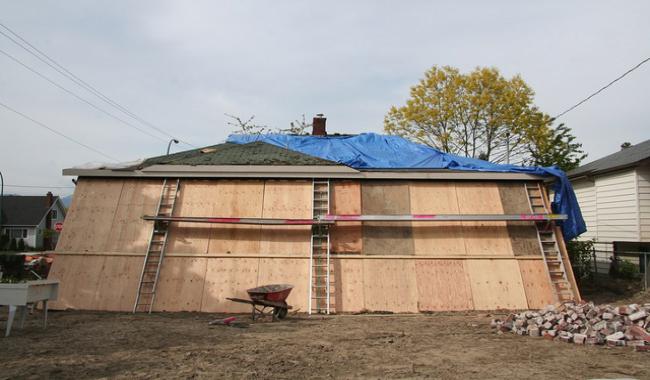
Photo by Mark Burge is licensed under CC BY 2.0
What is Tenant Habitability Program
The intent of the Tenant Habitability Program is to protect tenants from untenantable housing conditions and/or forced permanent displacement. If you plan to renovate, repair, or alter a building subject to the Rent Stabilization Ordinance (RSO), your proposed work may qualify within the scope of the Tenant Habitability Program.
Primary Renovation Program
Landlords wanting to take advantage of the Primary Renovation Cost Recovery program must first complete the requirements for the Tenant Habitability Program. Once the work has been completed, an application can be prepared for a Primary Renovation project.
Seismic Retrofit
City Council passed the Earthquake Hazard Reduction Ordinance to establish mandatory standards for earthquake hazard reduction in wood-frame buildings with soft, weak, or open-front walls and existing non-ductile concrete buildings.
Steps for Obtaining a Permit for a Rent Stabilized Property
Step 1: Complete the documents below and email them to: epermit.ladbs@lcity.org
- Primary Renovation Worksheet
- Permit Application
- Owner Builder Declaration (if applicable)
- Signature Declaration (if applicable)
Step 2: Submitted documents will be reviewed by a Plan Checker. If they are approved, you will be issued a permit.
Step 3: Depending on the nature of work you are applying for a permit for, a Tenant Habitability Program clearance may be required.
Qualifying Work
The following criteria is used to determine whether proposed permitted work is within the scope of the Tenant Habitability Program:
- The proposed work includes the replacement of existing water or gas supply lines or drain waste lines, or the installation of new waste lines;
- The proposed work includes the replacement of electrical wiring or circuits, the replacement of an electrical service panel, or the addition of new wiring or circuits;
- The proposed work includes the replacement or upgrading of a heating, ventilation, or air conditioning (HVAC) system or the replacement, upgrading, or initial installation of an elevator system;
- The proposed work includes additions, modification or improvements to the foundation or to the structure (including the roof) that expose the building frame or compromise the building’s security, weather protection or fire protection; or
- The proposed work includes the abatement of hazardous materials, such as but not limited to lead-based paint and asbestos, in accordance with applicable federal, state and local laws.
Examples of work within the scope of Tenant Habitability Program
- Re-piping
- Seismic Retrofitting
- Substantial Alterations
- Re-wiring
What is a Tenant Habitability Plan (“THP”)
A Tenant Habitability Plan, commonly known as “THP,” is the heart of the Tenant Habitability Program. THP is a document prepared by a property owner with the assistance of the Department’s Tenant Habitability Program unit staff. The THP describes the scope of the work and the methods that the owner, contractor, and workers will use to mitigate potential impact to the tenants and the tenants’ personal property during the period that renovation work occurs in a tenant’s unit or the subject building and premises. At a minimum, a THP provides the following information, together with any other information the Department deems necessary, to ensure that the impact of renovation work and any related work upon affected tenants is adequately mitigated:
Required information:
- Identification of the landlord, the general contractor responsible for the renovation work, and any specialized contractor responsible for hazardous material abatement, including but not limited to lead-based paint and asbestos.
- Identification of all potentially affected tenants including the current rent each tenant pays and the date of each tenant’s last rent increase. In accordance with California Civil Code Sec. 1798 et seq., information regarding tenants shall be considered confidential.
- Description of the overall work to be undertaken on all affected units and common areas, the specific work to be undertaken on each affected unit, an estimate of the total project cost and time, and an estimate of the cost and time of renovation for each affected unit.
- Identification of the impact of the renovation work and related work on the habitability of affected rental units, including a discussion of impact severity and duration with regard to noise, utility interruption, exposure to hazardous materials, interruption of fire safety systems, inaccessibility of all or portions of each affected rental unit, and disruption of other tenant services.
- Identification of the mitigation measures that will be adopted to ensure that tenants are not required to occupy an untenantable dwelling, as defined in California Civil Code Section 1941.1, outside of the hours of 8:00 am through 5:00 pm, Monday through Friday, and are not exposed at any time to toxic or hazardous materials including, but not limited to, lead-based paint and asbestos. Such measures may include the adoption of work procedures that allow a tenant to remain on-site and/or the temporary relocation of tenants.
- Identification of the impact of the renovation work and related work on the personal property of affected tenants, including work areas which must be cleared of furnishings and other tenant property, and the exposure of tenant property to theft or damage from hazards related to work or storage.
- Identification of the mitigation measures that will be adopted to secure and protect tenant property from reasonably foreseeable damage or loss.
Cost Recovery
Property owners wanting to take advantage of the Primary Renovation Program or Seismic Retrofit Cost Recovery Programs must first complete the requirements for the Tenant Habitability Program. Once the work has been completed, an online application is available for either Cost Recovery Program.
Tenant Habitability Program Ordinance
Tenant Habitability Program ordinance is codified in the Los Angeles Municipal Code, Chapter XV, Article 2. To access Tenant Habitability Program ordinance click here.
Contact information for THP
If you are planning to commence seismic retrofit work and you need additional information regarding Tenant Habitability Program please email us at hcidla.code.seismic@lacity.org or call us at (213) 482-7039.
If you are planning to commence any other qualifying work mentioned above (other than seismic retrofit work) and you need additional information regarding Tenant Habitability Program please email us at hcidla.code.thp@lacity.org or call us at (213) 482-7039.



